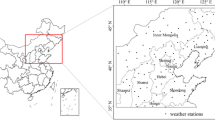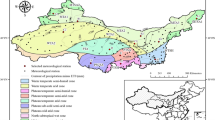Abstract
Drought identification is crucial to water resources management and planning. Different drought indices have been developed and their complexity and applicability vary. The objectives of this research are to develop a new integrated drought index with the capability of identification of drought and to further customize drought categorization for cold climate regions. Specifically, a new hydroclimatic aggregate drought index (HADI) is developed by coupling with a grid-based hydrologic model and applying the R-mode correlation-based principal component analysis. The HADI is a composite drought index, which assesses the anomalies of rainfall, surface runoff, snowmelt, and soil moisture in the root zone. Furthermore, joint probability distribution function of drought frequencies and classes as well as conditional expectation are used for drought categorization. The HADI was applied to the Red River of the North Basin (RRB) and its performance was evaluated by comparing with the Palmer Drought Severity Index (PDSI) and the U.S. Drought Monitor (USDM) products. Based on the impacts of drought on agriculture, the HADI outperformed the PDSI in identification of droughts in the RRB. Although the HADI and USDM showed a good agreement in identification of drought periods, the drought area coverages for each drought category from the two methods differed. The new customized drought categorization based on variable threshold levels accounted for the variations in both time and geographical locations. The new HADI, together with the customized drought categorization, is able to provide more accurate drought identification and characterization, especially for cold climate regions.

















Similar content being viewed by others
References
Agnew CT (2000) Using the SPI to identify drought. Drought Network News, vol 12, National Drought Mitigation Center, Lincoln, NE, 6–12. http://digitalcommons.unl.edu/cgi/viewcontent.cgi?article51000&context5droughtnetnews
Akinremi OO, Mcginn SM, Barr AG (1996) Evaluation of the Palmer Drought Index on the Canadian prairies. J Clim 9:897–905. https://doi.org/10.1175/1520-0442(1996)009%3c0897:EOTPDI%3e2.0.CO;2
Ali A, Lebel T (2009) The Sahelian standardized rainfall index revisited. Int J Meteorol 29(12):1705–1714. https://doi.org/10.1002/joc.1832
Bachmair S, Kohn I, Stahl K (2015) Exploring the link between drought indicators and impacts. Nat Hazards Earth Syst Sci 15:1381–1397. https://doi.org/10.5194/nhess-15-1381-2015
Bachmair S, Tanguy M, Hannaford J, Stahl K (2018) How well do meteorological indicators represent agricultural and forest drought across Europe? Environ Res Lett 13:034042. https://doi.org/10.1088/1748-9326/aaafda
Bayissa Y, Maskey S, Tadesse T, Andel V, Moges SJ, Van Griensven SA, Solomatine D (2018) Comparison of the performance of six drought indices in characterizing historical drought for the Upper Blue Nile Basin, Ethiopia. Geosciences 8(3):81. https://doi.org/10.3390/geosciences8030081
Bureau of Economic Analysis (BEA), U.S. Department of Commerce (2019) https://apps.bea.gov/regional/histdata/releases/0609gsp/index.cfm. 12 Nov 2019
Carrão H, Singleton A, Naumann G (2014) An optimized system for the classification of meteorological drought intensity with applications in drought frequency analysis. J Appl Meteorol Climatol 53(8):1943–1960. https://doi.org/10.1175/JAMC-D-13-0167.1
Cattell RB (1952) Factor analysis: an introduction and manual for the psychologist and social scientist. Greenport Press, Westport, p 462
Chu X, Lin Z, Tahmasebi Nasab M, Zeng L, Grimm K, Bazrkar MH, Wang N, Liu X, Zhang X, Zheng H (2018) Macro-scale grid-based and subbasin-based hydrologic modeling: joint simulation and cross-calibration. J Hydroinform 21(1):77–91. https://doi.org/10.2166/hydro.2018.026
Fry JA, Xian G, Jin S, Dewitz JA, Homer CG, Yang L, Barnes CA, Herold ND, Wickham JD (2011) Completion of the 2006 national land cover database for the conterminous united states. Photogramm Eng Remote Sens 77(9):858–864
Habtezion N, Tahmasebi Nasab M, Chu X (2016) How does DEM resolution affect microtopographic characteristics, hydrologic connectivity, and modeling of hydrologic processes? Hydrol Process 30(25):4870–4892. https://doi.org/10.1002/hyp.10967
Hänsel S, Schucknecht A, Matschullat J (2016) The Modified Rainfall Anomaly Index (mRAI)—is this an alternative to the Standardised Precipitation Index (SPI) in evaluating future extreme precipitation characteristics? Theor Appl Climatol 123(3–4):827–844. https://doi.org/10.1007/s00704-015-1389-y
Hao Z, AghaKouchak A (2013) Multivariate Standardized Drought Index: a parametric multi-index model. Adv Water Resour 57:12–18. https://doi.org/10.1016/j.advwatres.2013.03.009
Hogg RV, Craig AT (1978) Introduction to mathematical statistics, 4th edn. Macmillan Publishing Co., Inc., New York
HPRCC (2018) 30-year climate normals (1981–2010). High Plains Regional Climate Center. https://hprcc.unl.edu/maps.php?map5Normals. 12 Dec 2018
Kao SC, Govindaraju RS (2010) A copula-based joint deficit index for droughts. J Hydrol 380(1–2):121–134. https://doi.org/10.1016/j.jhydrol.2009.10.029
Karamouz M, Rasouli K, Nazif S (2009) Development of a hybrid index for drought prediction: case study. J Hydrol Eng 14(6):617–627. https://doi.org/10.1061/(ASCE)HE.1943-5584.0000022
Keyantash JA, Dracup JA (2004) An aggregate drought index: assessing drought severity based on fluctuations in the hydrologic cycle and surface water storage. Water Resour Res 40(9):1–14. https://doi.org/10.1029/2003WR002610
Li B, Liang Z, Yu Z, Acharya K (2014) Evaluation of drought and wetness episodes in a cold region (Northeast China) since 1898 with different drought indices. Nat Hazards 71(3):2063–2085. https://doi.org/10.1007/s11069-013-0999-x
MacQueen JB (1967) Some methods for classification and analysis of multivariate observations. In: Proceedings of 5-th Berkeley symposium on mathematical statistics and probability, vol 1. University of California Press, Berkeley, pp 281–297
McKee TB, Doesken NJ, Kleist J (1993) The relationship of drought frequency and duration to time scales. In: Proc. of AMS 8th conference on applied climatology. American Meteorological Society, Boston, pp 179–184
Mishra AK, Singh VP (2010) A review of drought concepts. J Hydrol 391(1):202–216. https://doi.org/10.1016/j.jhydrol.2010.07.012
Nalbantis I, Tsakiris G (2009) Assessment of hydrological drought revisited. Water Resour Manag 23(5):881–897. https://doi.org/10.1007/s11269-008-9305-1
NOAA’s National Centers for Environmental information (NOAA’s NCEI) (2019) Climate at a glance: divisional time series. https://www.ncdc.noaa.gov/cag/. Retrieved 9 Nov 2019
Palmer WC (1965) Meteorological drought. U.S. Weather Bureau, research paper no. 45
Rencher AC, Christensen WF (2012) Methods of multivariate analysis, 3rd edn. Wiley, New York
Richman MB (1986) Rotation of principal components. J Climatol 6(3):293–335. https://doi.org/10.1002/joc.3370060305
Sawada Y, Koike T, Jaranilla-Sanchez PA (2014) Modeling hydrologic and ecologic responses using a new eco-hydrological model for identification of droughts. Water Resour Res 50:6214–6235. https://doi.org/10.1002/2013WR014847
Shafer BA, Dezman LE (1982) Development of a surface water supply index (SWSI) to assess the severity of drought conditions in snowpack runoff areas. In: Proceedings of the 50th annual western snow conference, pp 164–175
Shukla S, Wood AW (2008) Use of a standardized runoff index for characterizing hydrologic drought. Geophys Res Lett 35(2):1–7. https://doi.org/10.1029/2007GL032487
Staudinger M, Stahl K, Seibert J (2014) A drought index accounting for snow. Water Resour Res 50(10):7861–7872. https://doi.org/10.1002/2013WR015143
Steinemann A (2003) Drought indicators and triggers: a stochastic approach to evaluation. J Am Water Resour Assoc 39(5):1217–1233. https://doi.org/10.1111/j.1752-1688.2003.tb03704.x
Svoboda M, LeComte D, Hayes M, Heim R, Gleason K, Angel J, Rippey B, Tinker R, Palecki M, Stooksbury D, Miskus D, Stephens S (2002) The drought monitor. Bull Am Meteor Soc 83(8):1181–1190. https://doi.org/10.1175/1520-0477(2002)083%3c1181:TDM%3e2.3.CO;2
Tahmasebi Nasab M, Grimm K, Bazrkar MH, Zeng L, Shabani A, Zhang X, Chu X (2018) SWAT modeling of non-point source pollution in depression-dominated basins under varying hydroclimatic conditions. Int J Environ Res Public Health 15(11):2492. https://doi.org/10.3390/ijerph15112492
Tilahun K (2006) Analysis of rainfall climate and evapo-transpiration in arid and semi-arid regions of Ethiopia using data over the last half a century. J Arid Environ 64(3):474–487. https://doi.org/10.1016/j.jaridenv.2005.06.013
Tollerud H, Brown J, Loveland T, Mahmood R, Bliss N (2018) Drought and land-cover conditions in the great plains. Earth Interact 22(17):1–25. https://doi.org/10.1175/EI-D-17-0025.1
US Drought Portal (2018). https://www.drought.gov/drought/states/north-dakota. 13 Nov 2018
USDM (2019) United States drought monitor. https://droughtmonitor.unl.edu/Data/Timeseries.aspx. 27 June 2019
Van Loon AF, Laaha G (2015) Hydrological drought severity explained by climate and catchment characteristics. J Hydrol 526:3–14. https://doi.org/10.1016/j.jhydrol.2014.10.059
Van Loon AF, Van Lanen HAJ (2012) A process-based typology of hydrological drought. Hydrol Earth Syst Sci 16(7):1915–1946. https://doi.org/10.5194/hess-16-1915-2012
Van Loon AF, Stahl K, Di Baldassarre G, Clark J, Rangecroft S, Wanders N, Gleeson T, Van Dijk AIJM, Tallaksen LM, Hannaford J, Uijlenhoet R, Teuling AJ, Hannah DM, Sheffield J, Svoboda M, Verbeiren B, Wagener T, Van Lanen HAJ (2016) Drought in a human-modified world: reframing drought definitions, understanding, and analysis approaches. Hydrol Earth Syst Sci 20(9):3631–3650. https://doi.org/10.5194/hess-20-3631-2016
Vicente-Serrano Sergio M, Juan SB, López-Moreno I (2010) A multiscalar drought index sensitive to global warming, the standardized precipitation evapotranspiration index. J Clim 23:1696–1718. https://doi.org/10.1175/2009JCLI2909.1
Wilhite DA, Glantz MH (1985) Understanding the drought phenomenon: the role of definitions. Water Int 10(3):111–120. https://doi.org/10.1080/02508068508686328
Wilhite DA, Hayes MJ, Svoboda MD (2000) Drought monitoring and assessment: status and trends in the United States. In: Vogt JV, Somma F (eds) Drought and drought mitigation in Europe. Advances in natural and technological hazards research, vol 14. Springer, Dordrecht, pp 149–160. https://doi.org/10.1007/978-94-015-9472-1_11
Wu H, Hayes M, Wilhite JDA, Svoboda MD (2005) The effect of the length of record on the standardized precipitation index calculation. Int J Climatol 25(4):5050–5520. https://doi.org/10.1002/joc.1142
Xu Y, Wang L, Ross KW, Liu C, Berry K (2018) Standardized soil moisture index for drought monitoring based on soil moisture active passive observations and 36 years of North American Land Data Assimilation System data: a case study in the Southeast United States. Remote Sens. https://doi.org/10.3390/rs10020301
Zargar A, Sadiq R, Naser B, Khan FI (2011) A review of drought indices. Environ Rev 19:333–349. https://doi.org/10.1139/a11-013
Acknowledgements
This material is based upon work supported by the National Science Foundation under Grant No. NSF EPSCoR Award IIA-1355466. The North Dakota Water Resources Research Institute also provided partial financial support in the form of a graduate fellowship for the first author.
Author information
Authors and Affiliations
Corresponding author
Ethics declarations
Open access
The datasets for this research are available at the Bureau of Economic Analysis (BEA): https://apps.bea.gov/regional/histdata/releases/0609gsp/index.cfm, the NOAA’s National Centers for Environmental information (NOAA’s NCEI): https://www.ncdc.noaa.gov/cag/, and the United States Drought Monitor (USDM): https://droughtmonitor.unl.edu/Data/Timeseries.aspx. The modeling data generated from this study will be eventually uploaded to the UND Scholarly Commons and will be available for any interested readers.
Additional information
Publisher's Note
Springer Nature remains neutral with regard to jurisdictional claims in published maps and institutional affiliations.
Rights and permissions
About this article
Cite this article
Bazrkar, M.H., Zhang, J. & Chu, X. Hydroclimatic aggregate drought index (HADI): a new approach for identification and categorization of drought in cold climate regions. Stoch Environ Res Risk Assess 34, 1847–1870 (2020). https://doi.org/10.1007/s00477-020-01870-5
Accepted:
Published:
Issue Date:
DOI: https://doi.org/10.1007/s00477-020-01870-5




